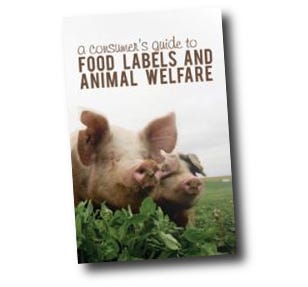March 11, 2015

Consumer Guide to Food Labels
Many food labels are confusing—and some downright misleading—especially with regard to animal welfare claims. To help navigate the confusion, the Animal Welfare Institute (AWI) has released A Consumer's Guide to Food Labels and Animal Welfare. The new guide aims to help consumers who purchase meat, dairy and eggs interpret the meaning of label claims and locate products from animals that were humanely raised and handled.
AWI's label guide defines the most common claims related to farm animal welfare and places them into one of three categories:
1. Certified Labels (such as "Animal Welfare Approved," "Certified Humane" and "USDA Organic") are defined by a formal set of publicly available animal care standards, and compliance with those standards is verified by a third-party audit. Consumers should look for these labels.
2. Unverified Claims (such as "cage free," "free range" and "pasture raised") are relevant to animal welfare but the standards are vague and/or weak, and compliance isn't verified by an independent audit. While not as reliable as certified labels, consumers should choose these products over products without any welfare claims.
3. Meaningless or Misleading Claims (such as "natural," "no added hormones" when used on poultry or pork, and "cage free" when used on meat chicken or turkey) are meaningless or misleading in terms of animal welfare. Consumers should avoid products with these claims.
When consumers in a survey by Demeter Communications were asked what they would like to know about food production that they didn't currently know, more than two-thirds said they wanted to know what farmers are doing to ensure animal care.
In another survey commissioned by the U.S. Farmers and Ranchers Alliance, 70 percent of consumers said their food purchasing decisions are influenced by how food is grown or raised. However, while consumers want this information, they are not currently receiving it from package labels—the preferred source of information for a large majority of shoppers. For example, only 2 percent of consumers responding to a survey conducted for AWI were able to correctly identify the definition of "natural" when used on meat products.
"The welfare of animals raised for food is important to consumers and is increasingly a strong consideration in buying food," says Dena Jones, AWI's farm animal program manager. "Unfortunately, few people outside the food industry and U.S. Department of Agriculture understand the meaning of the various claims used on packaging. This guide helps consumers decipher label claims and make decisions consistent with their values regarding how animals raised for food should be treated."
The guide is available in both pocket-sized and full-length versions.
Source: Animal Welfare Institute (AWI)
.
About the Author(s)
You May Also Like


